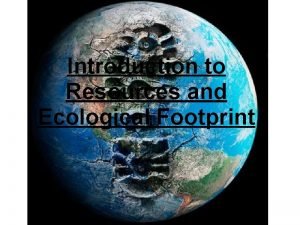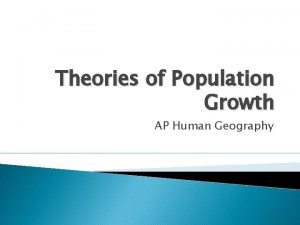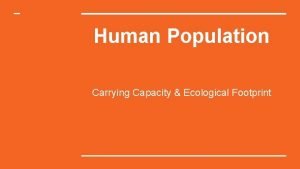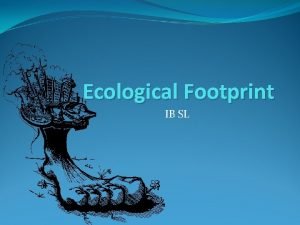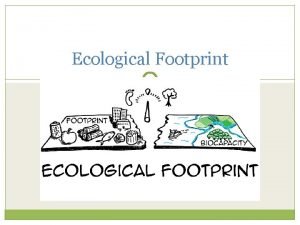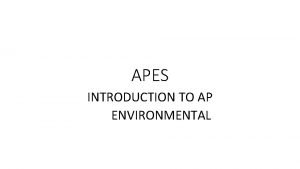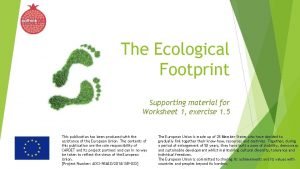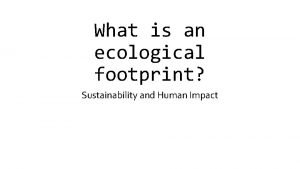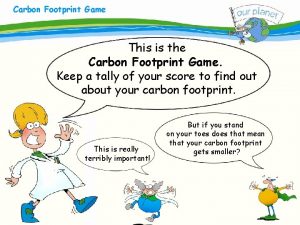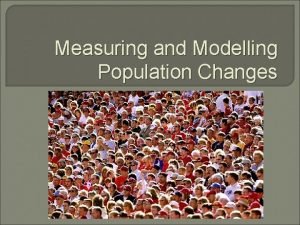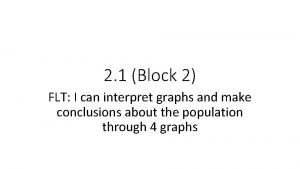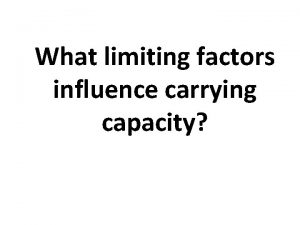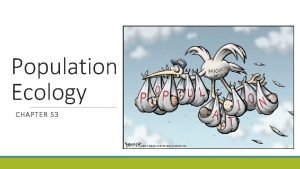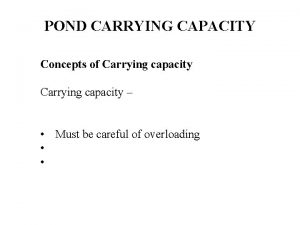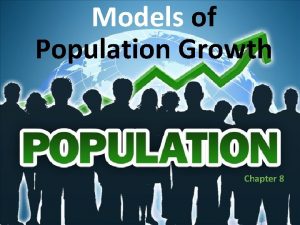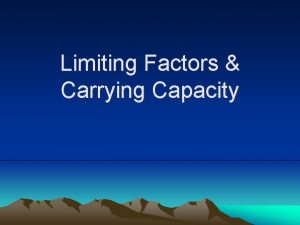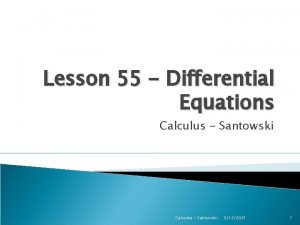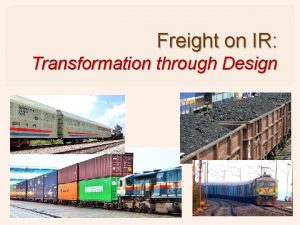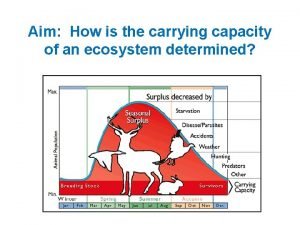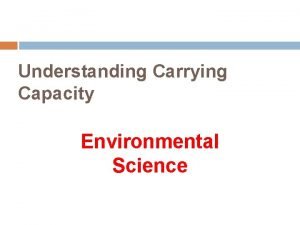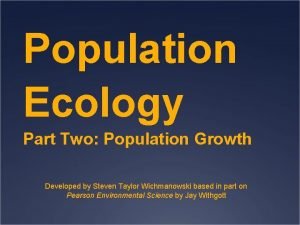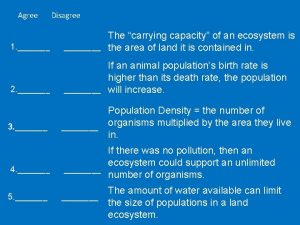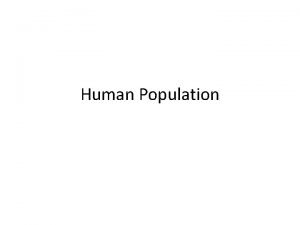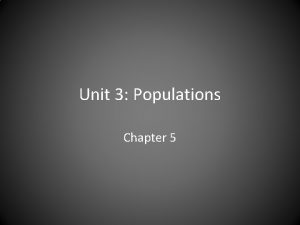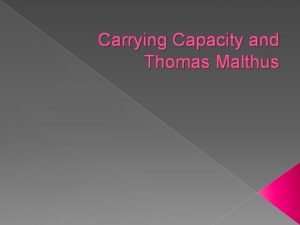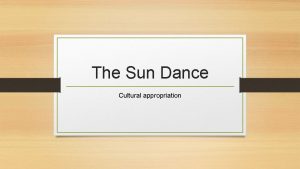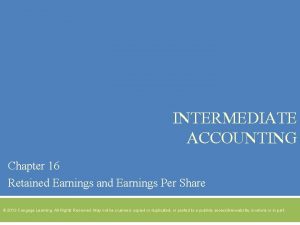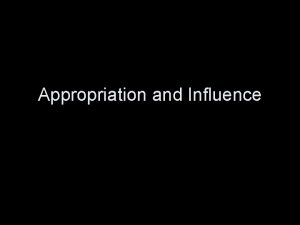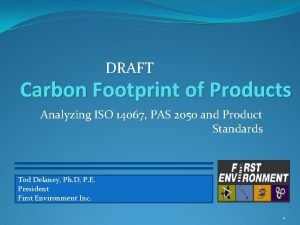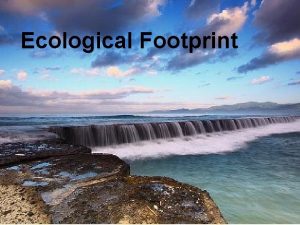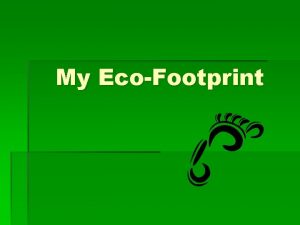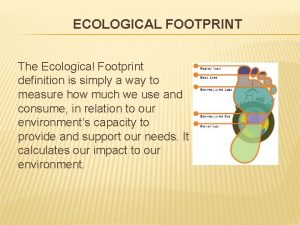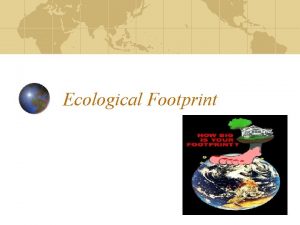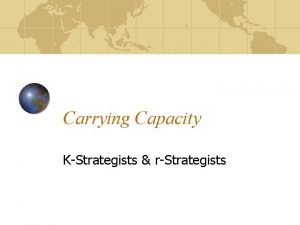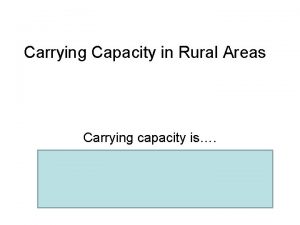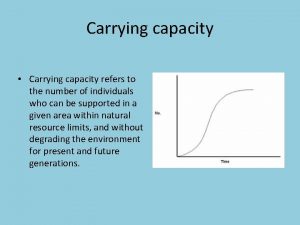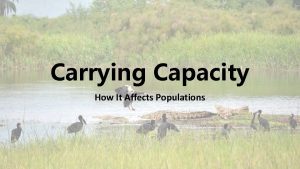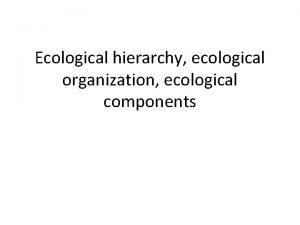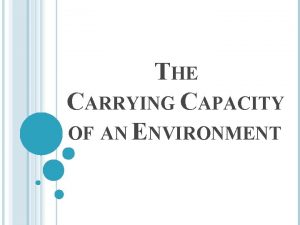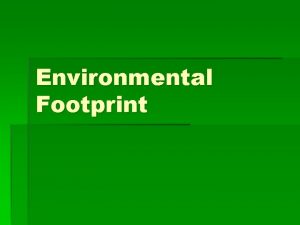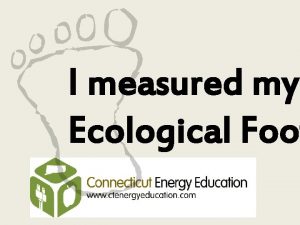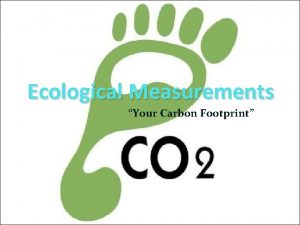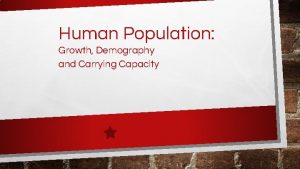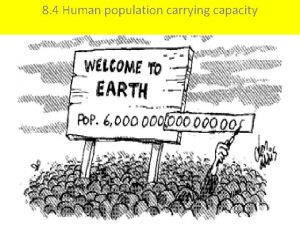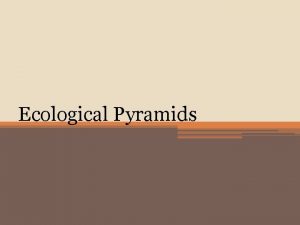Carrying Capacity human appropriation and the Ecological Footprint










































- Slides: 42

Carrying Capacity, human appropriation and the Ecological Footprint Readings. Vitousek 1986, Postel et al, 1996, rprogress. org optional – Daly et al 1992

Carrying Capacity • Upper limit to the ultimate size - carrying capacity (CC): • Logistic or density dependent growth Growth determined by: Pt = Pt-1 + r* Pt-1 * (CC - Pt-1)/CC Can we measure cc? Does it make sense to measure CC?

Carrying Capacity • Definition: The maximum population of a species an area can support without reducing its ability to support the same species in the future • Function both of the area and the organism (ex. Ceteris paribus Larger area higher cc)

Different CC for different species • Human carrying capacity – Complicated by individual differences in the amount and quality of resources consumed and the evolution in the types and quantity of the stuff we consume. – Issues? – Is it static?

Categories of CC • Biophysical carrying capacity – Maximum population size that could be sustained biophysically given certain technological capabilities • Social carrying capacity – maximum population that can be sustained under varying social systems. – Smaller than biophysical cc

Estimating CC • Total area times productivity/ccal needed to survive (e. g. ) • Total area times productivity of that area – divided by total kcal required to survive. – How many calories people need to survive. – 5. 9 billion people. • Useful? Realistic? Are we already appropriating too much?

A closer look 1 Human appropriation of the products of photosynthesis • Vitousek et al. 1986 • Examined the impact on the biosphere by calculating the NPP (Net primary production) that humans have appropriated • Seminal study

Human appropriation of the products of photosynthesis • NPP: is the amount of energy left after subtracting the respiration of primary producers from the total amount of energy that is fixed biologically through photosynthesis • Total food resource on the earth

Human appropriation of the Products of Photosynthesis • Three calculations: • Low estimate: The NPP used directly for food, fuel, timber or fibers • Intermediate estimate: The productivity of land that is entirely devoted to human activities • High estimate: The above and productive capacity lost due to land conversion

Human appropriation of the Products of Photosynthesis • Low Calculation: – Consumption or production of grain – Consumption by life-stock – Forests – Aquatic ecosystems => 3% of all NPP

Human appropriation of the Products of Photosynthesis • Intermediate calculation – Includes what is co-opted by humans • • Cropland Pasture land Forests use and conversion Others such as lawns, golf courses and gardens =>19. 9% of total NPP.

Human appropriation of the Products of Photosynthesis • High calculation – Includes losses in productivity • Replacement of natural ecosystems with agricultural systems • Forest conversion to pasture • Desertification • Areas occupied by humans =>40% of terrestrial NPP, 25% of global NPP

A closer look 2 Human Appropriation of the products of freshwater • Objective: • Assess how much of the Earth’s renewable freshwater is realistically accessible to humans • Assess how much humans use directly

Human Appropriation of the Products of Freshwater • Terrestrial renewable freshwater = Precipitation = Evapotranspiration + Eventual runoff to the sea • Evapotranspiration (EP): Based on how much of NPP we use (use high estimate) => We appropriate 26% of all EP

Human Appropriation of the Products of Freshwater • Total runoff (40, 700 km 3/year): – Not accessible runoff excluded – Accessible (12, 500 km 3/year) • Withdrawals, consumption (we use 36% of all) • Instream uses (we use 18% of all) – Total appropriated 54%

Conclusion • Humans appropriate 30% of accessible RFWS • Humans appropriate 23% of all RFWS • Total runoff appropriated 54%

The ecological footprint • Is a measure of the load imposed by a given population on nature. • Represents the land area required to sustain a given level of resource consumption and waste discharge by that population • The land area required to provide the energy and material requirements by the economy (measured in ha)

Measuring • The land required to sustain a particular human population - that is the area of land of various classes that is required on a continued basis to: – Provide all the energy and material resources consumed – Absorb all the wastes that assimilate

The Concept

Core footprint issues • • • Current industrial practices are sustainable Include only basic natural services Try not to double count Simplify the ecological productivity values Not really account for marine areas

The Calculation 4 Steps Step 1. • Consumption of various goods and services • Measured in Kg consumed/capita • C

The Calculation • Step 2. • Assess the productivity of each land category required (given in program) • Defined as how much land area is required to produce a particular amount • Use global averages • Measured in kg/ha • P

Calculation Step 3. • Assess the land mass appropriated per capita for the production of each consumption item. • Measured in hectare per capita => aa = C/P = (kg/capita)/(kg/ha) = ha/capita

Calculation • Step 4. • Sum over all aa – to get total EF Þ∑aa, giving EF per capita per population Then of course you can multiply the total EF per capita by total population to get EF per nation.

Calculation • Sustainability factor • EF/total land area available • Should be smaller than 1

Calculation – a closer look Step 1. Consumption Items • Food • Housing • Transportation • Consumer goods • Services

Consumption Categories

A closer look – Step 2 • 8 Main land-use categories – Energy – Consumed land – Currently used land – Land of limited availability

Land-use Categories

Productivity

A closer look: The landconsumption Matrix

Overview

Results in a global context • United States – 9. 7 ha/capita • Canada – 8. 4 ha/capita - NS - 8. 1 ha/capita - AB - 7. 9 ha/capita • France – 5. 3 ha/capita • Japan – 4. 8 ha/capita • Zimbabwe – 1. 3 ha/capita • Bangladesh – 0. 5 ha/capita Global Average: 2. 3 hectares/capita

Regional footprints

Some results • North American average 9, 7 ha/person • Total land required 9, 7*6 billion • Require 57 billion - only have 13 ha productive (need 4 earths) • Average footprint is 2, 3 ha/person - need 13, 8 billion ha

EF Applications • Region (country, province, town, university campus) • Personal Ecological Footprint (redefining progress, mountain equipment co-op) • Competing technologies (fuel cells) • Growing Techniques (field tomato vs. hydroponic tomato) • Policy decisions (rail vs. road, urban planning decisions) • Purchase decisions (cradle to grave) • Other (big mac, aquaculture, newspaper)

EF in Use • Teach concepts of sustainability, environmental issues, responsibility. • Benchmark of School Sustainability (define current state, assess progress -- footprint increase? Footprint decrease? ) • Means of Comparison (between schools, between grades, students vs. teachers) • Promote holistic decision making

Fun with footprints 1. How much ecologically productive land is needed to sequester all the CO 2 emissions released by the average Icelander’s fossil fuel consumption? Assume: Fossil fuel consumption 160 GJ/cap/year Productivity of energy land 100 GJ/HA

Fun with footprints • How much area do you need to produce paper for the average Icelander? • 113 kg paper/cap/yr • Each metric ton requires 1, 8 M^3 of wood • Wood productivity 2, 3 M^3/ha/yr

Fun with footprints • The ecological footprint of various modes of transportation in Reykjavik • Ecological footprint of vegans vs others • Ecological footprint of the University

Advantages of the concept • • • Is clear and understandable Are we living beyond our means? Can be used in the Local Agenda 21 process Can be used as a benchmarking tool Can be used to public relations, information, motivation or forming public opinion • Can be used comparatively – Nations, regions – Technologies, behaviors

Disavantages • • • Is static Assumes no changes in productivity Assumes equal productivity everywhere Requires more sectors? Requires more products?
 Ecological footprint ap human geography example
Ecological footprint ap human geography example Carrying capacity ap human geography
Carrying capacity ap human geography Islandwood ecological footprint
Islandwood ecological footprint Ecological footprint map
Ecological footprint map Ecological footprint components
Ecological footprint components Overshoot definition apes
Overshoot definition apes Save natural resources images
Save natural resources images Calculating ecological footprint involves consideration of
Calculating ecological footprint involves consideration of Whats an ecological footprint
Whats an ecological footprint Ecological footprint game
Ecological footprint game Relationship between population and carrying capacity
Relationship between population and carrying capacity Exponential growth and carrying capacity
Exponential growth and carrying capacity Limiting factor definition
Limiting factor definition Population
Population Carrying capacity of pond
Carrying capacity of pond S and j curves
S and j curves Whats carrying capacity
Whats carrying capacity Calculus equations
Calculus equations The information carrying capacity of a hologram is...
The information carrying capacity of a hologram is... Boxns wagon dimensions
Boxns wagon dimensions What is the carrying capacity (approx.)?
What is the carrying capacity (approx.)? Carrying capacity environmental science
Carrying capacity environmental science Carrying capacity exponential growth
Carrying capacity exponential growth Carrying capacity
Carrying capacity Carrying capacity
Carrying capacity Carrying capacity
Carrying capacity Thomas malthus carrying capacity
Thomas malthus carrying capacity Design capacity and effective capacity examples
Design capacity and effective capacity examples Sun dance definition
Sun dance definition Touching spirit bear cultural appropriation
Touching spirit bear cultural appropriation Intermediate accounting chapter 16
Intermediate accounting chapter 16 Appropriation account
Appropriation account Muzika ruscha
Muzika ruscha Just dance cultural appropriation
Just dance cultural appropriation Dada fountain
Dada fountain Appropriation art
Appropriation art Pieuvre cahier des charges
Pieuvre cahier des charges Durganand sinha ecological model diagram
Durganand sinha ecological model diagram Digital footprint examples
Digital footprint examples What is a digital footprint
What is a digital footprint Calculate digital footprint
Calculate digital footprint Iso 14067
Iso 14067 Devon nicholson
Devon nicholson
